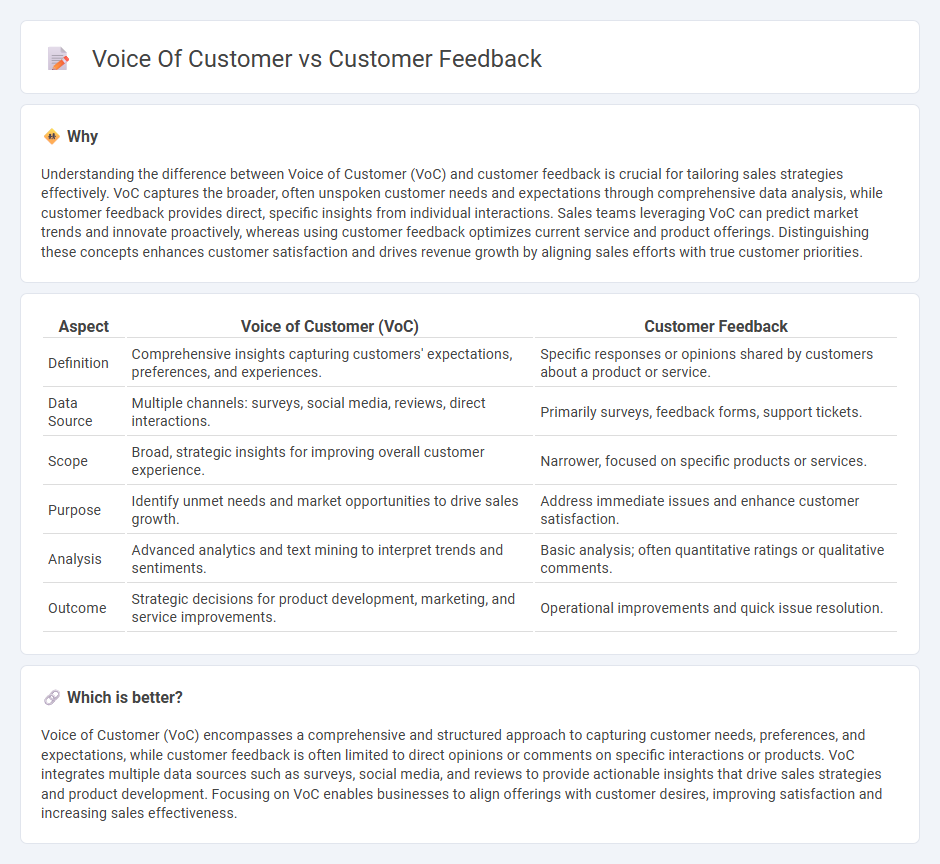
Voice of Customer (VoC) captures the detailed expectations, preferences, and aversions directly from customers, providing a strategic framework for businesses to enhance their offerings. Customer feedback consists of reactions and evaluations on specific products or services, offering actionable insights for immediate improvements. Explore how leveraging VoC and customer feedback can drive sales growth and customer satisfaction.
Why it is important
Understanding the difference between Voice of Customer (VoC) and customer feedback is crucial for tailoring sales strategies effectively. VoC captures the broader, often unspoken customer needs and expectations through comprehensive data analysis, while customer feedback provides direct, specific insights from individual interactions. Sales teams leveraging VoC can predict market trends and innovate proactively, whereas using customer feedback optimizes current service and product offerings. Distinguishing these concepts enhances customer satisfaction and drives revenue growth by aligning sales efforts with true customer priorities.
Comparison Table
| Aspect | Voice of Customer (VoC) | Customer Feedback |
|---|---|---|
| Definition | Comprehensive insights capturing customers' expectations, preferences, and experiences. | Specific responses or opinions shared by customers about a product or service. |
| Data Source | Multiple channels: surveys, social media, reviews, direct interactions. | Primarily surveys, feedback forms, support tickets. |
| Scope | Broad, strategic insights for improving overall customer experience. | Narrower, focused on specific products or services. |
| Purpose | Identify unmet needs and market opportunities to drive sales growth. | Address immediate issues and enhance customer satisfaction. |
| Analysis | Advanced analytics and text mining to interpret trends and sentiments. | Basic analysis; often quantitative ratings or qualitative comments. |
| Outcome | Strategic decisions for product development, marketing, and service improvements. | Operational improvements and quick issue resolution. |
Which is better?
Voice of Customer (VoC) encompasses a comprehensive and structured approach to capturing customer needs, preferences, and expectations, while customer feedback is often limited to direct opinions or comments on specific interactions or products. VoC integrates multiple data sources such as surveys, social media, and reviews to provide actionable insights that drive sales strategies and product development. Focusing on VoC enables businesses to align offerings with customer desires, improving satisfaction and increasing sales effectiveness.
Connection
Voice of Customer (VoC) captures direct insights and emotions expressed by customers during interactions, while customer feedback provides structured responses through surveys, reviews, and ratings. Together, VoC and customer feedback enable sales teams to identify pain points, enhance product offerings, and tailor sales strategies to meet evolving customer needs. Leveraging these data sources improves customer satisfaction, drives higher conversion rates, and boosts overall sales performance.
Key Terms
Surveys
Customer feedback refers to the specific responses collected through surveys, capturing direct opinions on products or services, while Voice of Customer (VoC) encompasses a broader range of qualitative and quantitative data including surveys, social media, and reviews. Surveys play a critical role in both by providing structured, measurable insights that help identify customer needs and satisfaction levels. Explore how integrating advanced survey techniques enhances Voice of Customer programs for deeper, actionable intelligence.
Net Promoter Score (NPS)
Customer feedback encompasses all types of input from clients, including surveys, reviews, and direct comments, while Voice of Customer (VoC) is a structured approach to capturing the complete customer experience and expectations. Net Promoter Score (NPS) is a crucial metric within VoC programs that quantifies customer loyalty by categorizing respondents as promoters, passives, or detractors based on their likelihood to recommend a brand. Explore how integrating NPS with VoC insights can drive business growth and enhance customer satisfaction.
Sentiment Analysis
Customer feedback encompasses direct comments from users about products or services, while Voice of Customer (VoC) collects broader insights including emotions and expectations. Sentiment analysis processes this qualitative data to quantify customer attitudes, revealing patterns in satisfaction and pain points. Explore how advanced sentiment analysis tools transform feedback into actionable strategies for enhanced customer experience.
Source and External Links
7 Reasons Why Customer Feedback Is Important To Your Business - Customer feedback is crucial because it helps improve customer experience, enhances retention by addressing dissatisfaction promptly, and builds strong loyalty through continuous service improvements.
Customer Feedback Loops: Insights For Continuous Improvement - Customer feedback loops enable businesses to continuously collect and act on feedback, exemplified by Starbucks and Amazon successfully using customer input to innovate and improve services.
7 Types of Customer Feedback Examples to Drive Growth - Effective customer feedback involves both qualitative data (comments and narratives) and quantitative data (ratings and surveys), gathered through diverse channels such as social media, to gain deep insights into customer needs and improve offerings.
 dowidth.com
dowidth.com